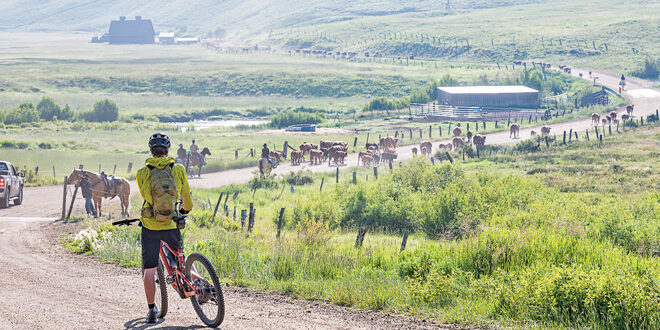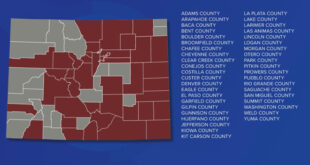Getting out the word about how ranchers care for public lands
By Ceighlee Fennel
(Editor’s Note: Freelance writer Ceighlee Fennel from Red Bluff, California passed through Crested Butte this spring and wrote a story highlighting the relationship between recreation and ranching in the valley. Part 2 examines the challenges ranchers deal with in terms of communicating to the public.)
Ranching has been a business in the Gunnison Valley for over a century. As recreation has become more popular, the interface between ranchers and recreationalists can at times be strained. Ranchers have been taking steps to try and alleviate some of the tensions.
“For the public to be aware of how much adaptation has taken place would be very helpful,” Stacy McPhail, executive director of Gunnison Ranchland Conservation Legacy, said. “It’s not easy to explain it, but I tell people we operate agriculturally here based on a single resource. Grass is that resource, so public lands are part of that mosaic.”
The Gunnison Ranchland Conservation Legacy (GRCL) is a nonprofit with the mission to conserve ranchlands and preserve ranching in the Upper Gunnison Watershed. McPhail mentioned that it was created as a response to land conversion by a collaborative group of businesses and citizens in the community who were interested in keeping the fabric of the community and agriculture cultural heritage intact in the face of development change.
Over the last 30 years, they have conserved roughly 65,000 acres in the watershed. Along with other (national) conservation groups, about 50% of Gunnison County agriculture lands are permanently protected by conservation easements.
The GRCL also owns and operates Trampe Ranches, a cow-calf operation with property in both ends of the valley. Most of the cow-calf operations in the basin use public lands for grazing, like the Spann Ranch. McPhail commented on the intersection between ranching and recreation on those public lands.
“We respect other people’s uses on the public lands, but when it comes to permitted use, we are permitted and there is a lot riding on us,” McPhail said. “If we don’t take care of the ground, it’s not available to us again. Recreation is not a use that always required a permit, so it’s difficult to balance the effects of those things on the range.”
Because ranchers have to pay for and take care of the land, some express frustration when recreation isn’t held to the same standards. As many ranchers have said, the public gets to use the resource for free and can leave damages behind.
“People think we get all of that grass for free from the government, but we have a fee that we pay, and every day we are out there, we are paying,” said Doug Washburn, a ranch manager for Spann Ranch. “People are out there using the same federal ground and paying zero for the use of it. The government has control over us, but they don’t control the amount of people who show up to recreate.”
Washburn also mentioned an idea of having recreators pay for permits similar to ranchers. He said even a small fee could help fund government efforts to maintain the land. Some motorized recreation pays for permits, but most non-motorized does not. He appreciates when recreation-based organizations help maintain trails and clean up the forests because they recognize the damage happening on the shared lands.
Dave Ochs, the executive director of the Crested Butte Mountain Bike Association, said that recreation has absolutely increased. “It was the summers of 2015 and 2016 when we saw real noticeable differences in numbers and negative impacts,” he said. “It’s why we created the Crested Butte Conservation Corps. It’s amazing to see how much this community rallies around its public lands and resources.”
The Conservation Corps not only cleans up public lands, it tries to educate locals and visitors on proper backcountry etiquette that ultimately benefits all the users, including ranching.
To ranch on much of the public land in the county, operators have to be permitted through the U.S. Forest Service (USFS). They pay a permit fee that varies depending on the type of livestock, permit type and the amount of animals grazing per month.
This can cost thousands of dollars just for grazing, not including permits and costs for fencing, water and range riding. They must also abide by the permit regulations which can range from the condition of the grass to yearly maintenance on infrastructures to where salt blocks can be located.
The Gunnison Ranger District has 40 active permits, and that number can vary slightly year from year based on which ones are renewed. The money collected from the permits can also vary because the USFS sets the rate annually nationwide. These fees do not go back to the local Ranger District budget, but instead go to the USFS.
The number of cattle in the North Valley changes every year, but there were 25,952 heads at the start of June this year. The permitted areas have not grown over the years because the allotment boundaries have remained constant. A helpful resource to see grazing rotation schedules, allotment maps and land management practices can be found on the USDA Forest Service website under the Gunnison Ranger District Grazing page.
Ranchers have to protect the land and resources because those are their lifeblood. They need hospitable land for the health of their herds. Local operating ranches provide open skies, healthy habitats and biodiversity. They irrigate meadows which benefits deer, elk and other wildlife. The irrigated meadows also help pull CO2 out of the atmosphere.
“The accusations that we are damaging the resource gets a little old because that would be shooting ourselves in the foot,” said Jan Washburn, a ranch manager and family member of Spann Ranch. “We are first and foremost environmentalists in caring for the resource we use every day.”
Without the working ranches, the local skyline might have fewer views of nature and more of condominium developments. It has long been argued in the Valley that the ranchers are protecting and caring for the land most residents and visitors hold dear.
“The community likes this kind of land use and wants it to stay on the private lands,” said McPhail. “We all know what is special about this place, but I think fewer people are aware of why it looks like it looks and how it feels.”
A large part of balancing ranching and recreation involves the mutual participation in advocacy and education. McPhail said positive outreach helps the community understand what they do and why they do it.
“Ranchers have always kind of been seen as being negative and saying no to things,” she said. “But they don’t have an aversion to recreation, they just aren’t sure what the capacity of that is. So, I think the conflict for us is making sure the public doesn’t lose that value [for ranching] for a lack of understanding of what it is.”
Currently, there are multiple forms of education for the public, including signs at trailheads, social media posts and ranching voices on committees, but McPhail mentions the fatigue ranchers have when it comes to explaining their perspective for 10-plus years. Some other ranchers mention having difficulties getting off the ranch and taking time to do outreach efforts when their ranching jobs are full time.
However, ranchers are using social media as a way to keep the public informed about when they are moving cattle and different aspects of their business. Jan Washburn mentioned receiving positive feedback from the community about her posts, and that people enjoy being kept in the loop.
“I think it makes a huge difference,” Jan said. “The ranching community has to justify our work and what we are doing because it interferes with what the public is doing. It’s an interesting job to have where you have to justify it.”
Next week Ceighlee delves into how organizations like the Conservation Corps, TAPP and STOR try to help bridge the gap between recreationists and ranchers…
 The Crested Butte News Serving the Gunnison Valley since 1999
The Crested Butte News Serving the Gunnison Valley since 1999



